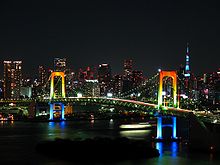Rainbow Bridge (Tokyo)
|
Rainbow Bridge レインボーブリッジ |
|
|---|---|
 |
|
| Coordinates | 35°38′11″N 139°45′49″E / 35.63639°N 139.76361°ECoordinates: 35°38′11″N 139°45′49″E / 35.63639°N 139.76361°E |
| Carries | Vehicle, Yurikamome, Pedestrian |
| Crosses | Tokyo Bay |
| Locale | Minato, Tokyo, Japan |
| Characteristics | |
| Total length | 798 m |
| Width | 49 m |
| Height | 126 m (towers), 52 m (roadway) |
| Longest span | 570 m |
| Number of spans | 3 |
| History | |
| Construction end | 1993 |
| Opened | August 26, 1993 |
The Rainbow Bridge (レインボーブリッジ Reinbō burijji?) is a suspension bridge crossing northern Tokyo Bay between Shibaura Pier and the Odaiba waterfront development in Minato, Tokyo, Japan.
It was built by Kawasaki Heavy Industries, with construction starting in 1987 and completed in 1993. The bridge is 798 metres (2,618 ft) long with a main span of 580 metres (1,903 ft). Officially called the "Shuto Expressway No. 11 Daiba Route - Port of Tokyo Connector Bridge," the name "'Rainbow Bridge" was decided by the public.
The towers supporting the bridge are white in color, designed to harmonize with the skyline of central Tokyo seen from Odaiba. There are lamps placed on the wires supporting the bridge, which are illuminated into three different colors, red, white and green every night using solar energy obtained during the day.
The bridge can be accessed by foot from Tamachi Station (JR East) or Shibaura-futō Station (Yurikamome) on the mainland side.
The Rainbow Bridge carries three transportation lines on two decks. The upper deck carries the Shuto Expressway's Daiba Route, while the lower deck carries the Yurikamome rapid transit system in the centre, walkways on the outer side, and Tokyo Prefectural Route 482 in-between. Route 482 was formerly a tolled road, but opposition to the toll led to its removal. Light motorcycles under 50cc are not permitted on either deck or the walkway of the bridge. Motorcycle pillion passengers are also banned.
...
Wikipedia
